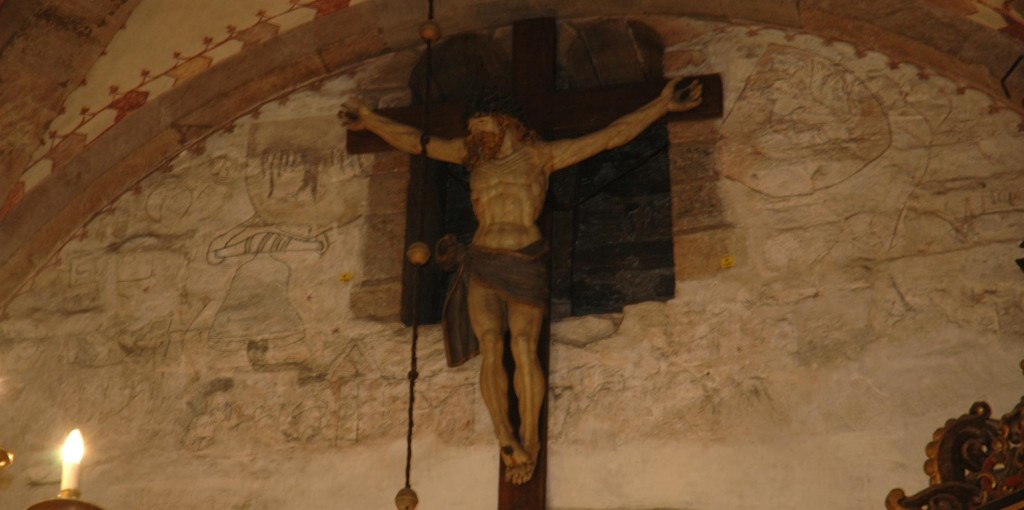Last Sunday, my wife and I attended an Anglican church service in Bergen, Norway. It reminded me of my childhood church, because the service was vacuous, anti-intellectual, and a complete waste of time. However, I’m glad we went, because it sparked some valuable thoughts about Christianity.
The building itself was historic, dating back to the 12th century. St. Mary’s Church. It’s beautiful on the inside. Hanging in the middle of the sanctuary is a life-sized replica of the crucifixion of Jesus. I’ve never seen anything like it. It was huge and disturbing, but my eyes kept coming back to it – probably because the actual service was so boring.
Growing up in the Christian Evangelical world, I’ve seen many crosses in my lifetime, but never one so realistic. As I stared, it hit me: the crucifixion is profound. Nevermind the theological claims – purely philosophically, it’s a powerful story.
Demonstration, not Articulation
I see two central concepts packed into the crucifixion: the Christian conception of love, and their pessimistic view of human beings.
From the start, you’ll have to forgive my ignorance. I don’t fully understand the significance of the crucifixion in mainstream Christianity. I’ve heard the arguments a thousand times, but I don’t grasp them. So, I can’t say whether my analysis is heretical or orthodox.
To me, the crucifixion is a demonstration of philosophy. The ideas are shown, not spoken. It’s a demonstration of love, a demonstration of hate, and a demonstration of commitment.
Love
As I’ve written about before, love is a mindset, and it radically re-orders your values. Instead of first desiring your own well-being, you first desire the well-being of another – even at the expense of yourself. In my case, the only person I’ve loved is my wife, and experiencing love was life-changing for me.
Jesus takes this conception of love to the extreme. He doesn’t say, “Love your wife and your family.” He says, “Love your neighbor. Love your enemy. Love everybody, without exception.” In other words, “Value others as highly as you value yourself – even at your own expense.” It’s a radical idea.
A unique part of this story is Jesus’s commitment to love. Taken to its logical end, his argument implies, “Be willing to die for strangers that hate you.” According to the canonical story, he wasn’t hypocritical about it; he actually died for strangers that hated him. It wasn’t a glamorous death, either. He was mocked, tortured, and executed.
This is where the replica affected me. Most people don’t see a crucifixion and think, “Now that’s love”. But given my prior experiences, that’s what I thought. In the extreme loving state of mind, I would do anything for Julia. I would even be willing to be crucified. That intensity of love can only be understood once you’ve experienced it. From the outside, I’m sure it looks like insanity.
 What also struck me is the physical position of the crucified body. It’s in a state of total openness and frailty – arms spread wide, unable to cover or defend itself. It’s a humiliating position, completely vulnerable, without even the ability to protect itself.
What also struck me is the physical position of the crucified body. It’s in a state of total openness and frailty – arms spread wide, unable to cover or defend itself. It’s a humiliating position, completely vulnerable, without even the ability to protect itself.
This, too, reminds me of the loving state of mind. You have to be 100% honest and real with your partner, and that means being completely vulnerable, to the point of heartbreak (or worse). When you reach that point, you aren’t in control of what happens. It’s as if your hands are physically nailed apart, and you cannot shield your heart from the other person.
Hate
In my analysis, love is one half of the crucifixion. Hate is the other half. Christians have a grim conception of what they call “the world” – i.e. human beings in their default state – where hatred plays a central role in the human psyche. Left to their own devices, humans are selfish, greedy, and barbaric hypocrites who aggressively reject the philosophy and mindset of love.
This is where you get the central juxtaposition. You have Jesus arguing for extreme, radical, and peaceful love, and he’s been crucified, mocked, spit upon, and hated by “the world” – love and hate, unified by the same act.
To the Christian, the world can tolerate liars and murderers – but it cannot tolerate true love.
Again, the physical position of the crucified body strikes me as poignant. It’s meant to mock and torture. Humans are essentially saying, “Oh yeah? Love is so great? How’s it working for you up there, buddy” – the implicit presupposition being, “If a philosophy is correct, it will result in happiness, wealth, and respect.” Therefore, since Jesus’s philosophy demonstrably lead to pain, humiliation, death, and derision, it must be wrong.
Plausible Analysis
I don’t know if your average Christian would agree with my analysis, but it seems like the most charitable understanding of the crucifixion without including any theology.
While I am sympathetic to the Christian conception of love, I remain undecided about their perspective of human nature. Are humans really so bad? I don’t know. Though I admit, I am growing more pessimistic by the week.
From my own experience, love does seem to polarize people. I’ve been mocked by those who think I’m naïve and deluded. And I expect they would be thrilled to learn if I got divorced, fell out of love, or was even killed.
As I investigate different religions, one thing is clear: their philosophic/ethical claims can be evaluated without need for any theology or dogma. The crucifixion of Jesus is profound, whether you think it’s a historical event, a supernatural event, or simply a metaphor.
